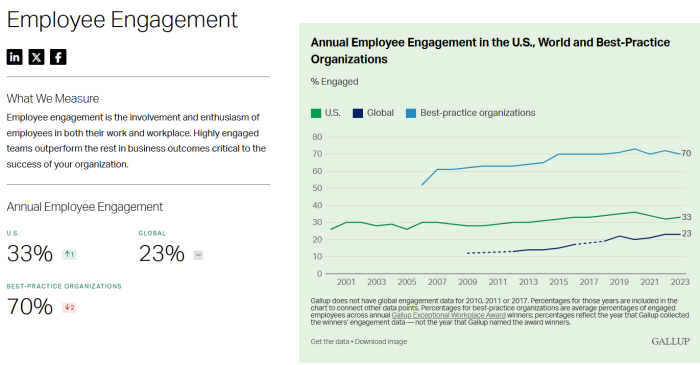Career Path Mapping: Data-Driven Insights to Fuel Professional Growth
 Publié le 15 August 2024
Publié le 15 August 2024
Utilize data-driven insights to fuel professional growth through career path mapping.
What are your goals for the future? Where do you see yourself in five years? These are questions you’ve probably been asked before in job interviews when applying for a new position.
However, how often, once you’ve got the job, do you really sit down and think about these questions again? And, if you’re an employer, how often do you actually ask your brilliant team members these questions once you’ve accepted their application?

Image Sourced from bls.gov
According to the U.S. Bureau of Labor Statistics, job tenures are shortening. In fact, they found that people between the ages of 18 and 54 had changed jobs 12.4 times! That’s a lot, and sadly for businesses, this high turnover means having to fork out on high recruitment costs. But why is this happening?
Well, because employees aren’t seeing an internal future with the company. Instead, they’re getting a lot of professional FOMO (fear of missing out) and are looking for new career paths elsewhere.
If you’re finding this to be an ongoing problem at your company, don’t worry. Career path mapping can help keep your employees loyal and retained! This complete guide will give you the lowdown on everything you need to know about it. Let’s get started.
What is Career Path Mapping?
Career path mapping (which is also referred to as career pathing or career mapping, FYI) is a way for employers and employees to work together to create visual plans that support both the company’s goals and the employee’s professional goals.
The main idea is to show all the job opportunities within your company so your employees want to stick around. No matter what their career aspirations or goals are, a career map helps them see the path ahead and move from one position to another, whether that’s moving up or sideways in the organization.
Career Path Mapping Components
Here’s what makes up a practical career map:
- Job description role cards: These lay out the exact details of each position at your company—like who they report to, what they do day-to-day, and how senior they are.
- Role competencies: Think of these as the must-have skills for each role. Whether it’s technical know-how, leadership skills, or job-specific talents.
- Skills and Competencies Breakdown: Just as a product breakdown structure (PBS) breaks down a product into its components, you can use a similar approach to break down each job role or career path into its essential skills and competencies, helping visualize what’s needed at every career stage and aiding in targeted development.
- Learning and development opportunities: Here’s where you show how you’ll support your team’s growth. If your employee wants to pivot into data, this might mean taking training sessions on topics like ‘what is data activation.’ Or, if they want to develop into management it could mean they need some mentoring or job shadowing.
- Personality types: This part digs into whether someone’s a natural leader or a great team player. It helps your team figure out where they’ll shine most based on their soft skills and where they’ll likely have the most job satisfaction.
Career Map Example
Let’s see this in action.
Suppose you work for a large data management firm. You’ve got this brilliant employee who is hungry to grow at your company. They’re fantastic at their job, and if you don’t act fast, you could risk losing them to another company. So what do you do?
You can sit down with them and discuss their career goals and interests. Maybe you find out that they want to specialize in ID resolution.
Or perhaps they dream of working as a data analyst. With this in mind, you can chart out a personalized career path for them, mapping out all the steps from their current role to where they want to be.
Benefits of Career Path Mapping
By now, you should have a decent understanding of what career path mapping is. But why should it be an absolute must at your company? Let’s take a look at some of the benefits:
Improves Employee Retention
Improving employee retention is a big deal because hiring new people on your team costs a pretty penny. When you offer your employees chances to move up within your company, they’re more likely to stick around.
Don’t just take our word for it! A 2022 report found that 28.3% of workers who left their jobs voluntarily resigned because they saw few opportunities for growth or advancement. Instead of waiting for your go-getter employees to start job hunting elsewhere, get ahead of the game.
Say you’re at a tech firm where a bunch of junior devs are leaving early, even though we pay well. They’re bouncing because they don’t see any chances to move up. Some think they’re not getting enough training on data basics like the ETL process or the latest programming languages. Others just feel stuck without a clear career path ahead.
With career path mapping in place, you could team up with training and development pros. Working together, you’d improve your team’s skills, offer killer training programs, and lay out clear career paths right here in the company. This’ll keep them happier and with you longer.
Better Employee Engagement
So here’s some not so great news for you. Most companies out there have an employee engagement issue. In fact, Gallup found that only 23% of employees feel engaged at work. The rest are just watching the clock or actively disengaged.

Image Sourced from gallup.com
This lack of motivation completely slows down productivity and innovation. On the other hand, Gallup also found that engaged employees result in:
- 23% higher profitability
- 18% higher productivity
- 14% higher productivity
- 18% lower turnover for high-turnover organizations
When companies invest in career mapping they can really boost their employee engagement significantly. Employees who see opportunities for advancement and development are more likely to stay motivated and committed.
Think about it. If you’ve got a sales rep starting out selling your IP business phone products. They can see a clear career path where they could move up to become a sales manager. Having that roadmap laid out makes them feel valued and eager to step up their game.
So, it’s not just about making work more enjoyable. No, it’s about creating a roadmap for success that benefits both your employees and your company’s bottom line.
Spotting Skills Gaps
Identifying skills gaps is super crucial when you’re plotting out your team’s career paths. It’s all about seeing where your team might need a bit of a skills boost to keep moving up. When you map out clear career paths, you can spot those gaps early on. That way, you can get ahead of the game and offer the right training or learning opportunities to fill those gaps.
Say you’ve got a rising star in your digital marketing team. They’re great at running ad campaigns but want to move up to manage the team. Through career mapping, you notice they could use more expertise in CRM retargeting (using customer data to fine-tune ad targeting).
So, you set up a personalized development plan. They attend workshops, get mentoring, and work on real projects. Now, they’re not just ready to lead, they’re boosting your team’s performance too!
Best Practices for Creating a Career Map
You’re officially up to speed on what career mapping is and why it’s so important – yay! Now, it’s time to get practical. Follow these best practices and steps to create a winning career map:
Check your Company’s Organizational Chart
Start with your company’s existing org chart, which basically outlines the hierarchy of roles. Make sure that it’s up to date and reflects any recent changes.
If you plan on adding new roles to align with future company objectives, incorporate these into your career mapping plan. That way, your employees can plan their internal moves toward positions that may become available in a year or two.
Build your Career Paths
Free to use image sourced from Stockvault
Now, take a closer look at how different job roles connect within your company to foster internal mobility. Careers aren’t always a simple A-to-B journey, so create pathways that cross departments.
For example, if you start as a customer service rep handling inquiries, you might explore opportunities in sales or marketing down the line. As part of this exploration, training in essential digital marketing skills such as email marketing can be important, enabling employees to develop new skills and grow towards their dream jobs.
Think of it more like a career lattice with lots of sideways opportunities rather than a traditional career ladder that only goes straight up. This allows for flexibility and lets employees explore diverse paths to advancement.
Write Down Career Competencies
Lay out exactly what skills and qualifications are needed in your job descriptions.
First off, you’ve got your core competencies. These are the skills that everyone in your organization should have (like communication skills or teamwork abilities).
Then, for each specific role, you’ll get into the specifics. Maybe it’s leadership skills or technical skills like coding or knowledge of industry-specific software. Or perhaps it’s certain qualifications or years of experience that are essential.
When you spell out these competencies in your job descriptions, you’re cutting down on any confusion about what the role entails. This clarity helps both current employees and potential hires understand exactly what’s expected. Plus, it sets a clear path for growth and development.
Keep Company Goals in Mind
Free to use image sourced from Stockvault
When you’re building your career map, it’s really important to align with your company’s overarching goals and objectives. This means not only considering the roles that exist now but also predicting future needs—say, in the next 1 to 5 years.
While it’s tempting to map out paths to roles where your current employees could excel, make sure these roles actually align with what the company actually needs. There’s no point in defining a career path to a role that doesn’t contribute to the organization’s objectives, even if it seems like a perfect fit for someone on your team.
By keeping your company’s goals at the forefront, you guarantee that your career mapping efforts will be strategic and impactful.
Figure Out Learning and Development Needs
Free to use image sourced from Unsplash
Now that your career map is set, it’s time to evaluate how well your current employee development systems support the path forward. Take a good look at the training and mentoring programs you already have in place to help individuals progress.
Start by checking in with your team. A quick survey can tell you if they’re happy with the training offered. It’s an easy way to find out what’s working well and what can be improved.
Another valuable source of insight is exit interviews. Reviewing these or similar documentation can reveal why employees leave and shed some much-needed light on potential gaps in your development strategies.
Finally, assess your mentoring, coaching, consulting services or job shadowing programs. Are they effective in guiding employees along their career paths? Understanding their impact helps ensure they’re aligned with the growth opportunities outlined in your career map.
Enhance Training Programs
Based on your evaluation, pinpoint any gaps and initiate new training and development initiatives to support your employees’ success. This might involve:
- Allocating a clear budget for training needs.
- Encouraging leaders to actively mentor their teams.
- Implementing job rotations to broaden employees’ skills and experiences.
- Utilizing the intranet to centralize all training materials and resources, ensuring employees have easy and immediate access to the tools they need to succeed.
Boost Employee Awareness
Once finalized, share your career map with your team—both seasoned staff and new hires during onboarding—to highlight the exciting growth paths available within your organization.
Include inspiring career stories of employees who’ve successfully navigated internal moves. This can motivate others to explore their own career development opportunities.
For instance, you could showcase how your employee started as a junior analyst but, through targeted training and mentorship, advanced to become a senior data scientist. Their journey can demonstrate to others that with dedication and support, similar growth opportunities are within reach.
Final Thoughts
So there you have it. Our complete guide on career mapping, packed with everything you need to know about the career path mapping process and how to do it at your awesome company.
Keep in mind that career mapping isn’t a one-time thing. It’s a tool that changes as your company and your people grow. Keep talking to your team, listen to their feedback, and adjust your career map to fit their changing needs and ambitions.
This ongoing effort not only makes employees happier and more likely to stick around but also builds a culture where everyone keeps learning and getting better.
As you start using career mapping, celebrate the wins. Share stories of people who’ve done well and grown with your company because of it. These stories inspire others and show how investing in your team’s development pays off.
In the end, career path mapping isn’t just about planning careers—it’s about building a team that’s ready for whatever the future brings. Here’s to finding new opportunities and achieving even more together!







